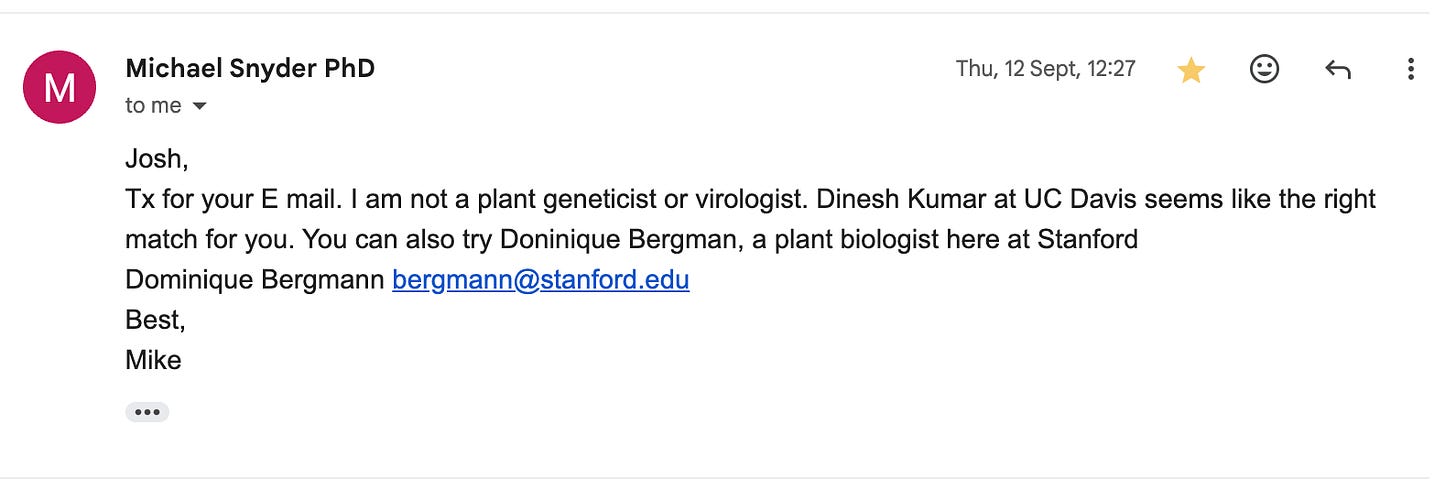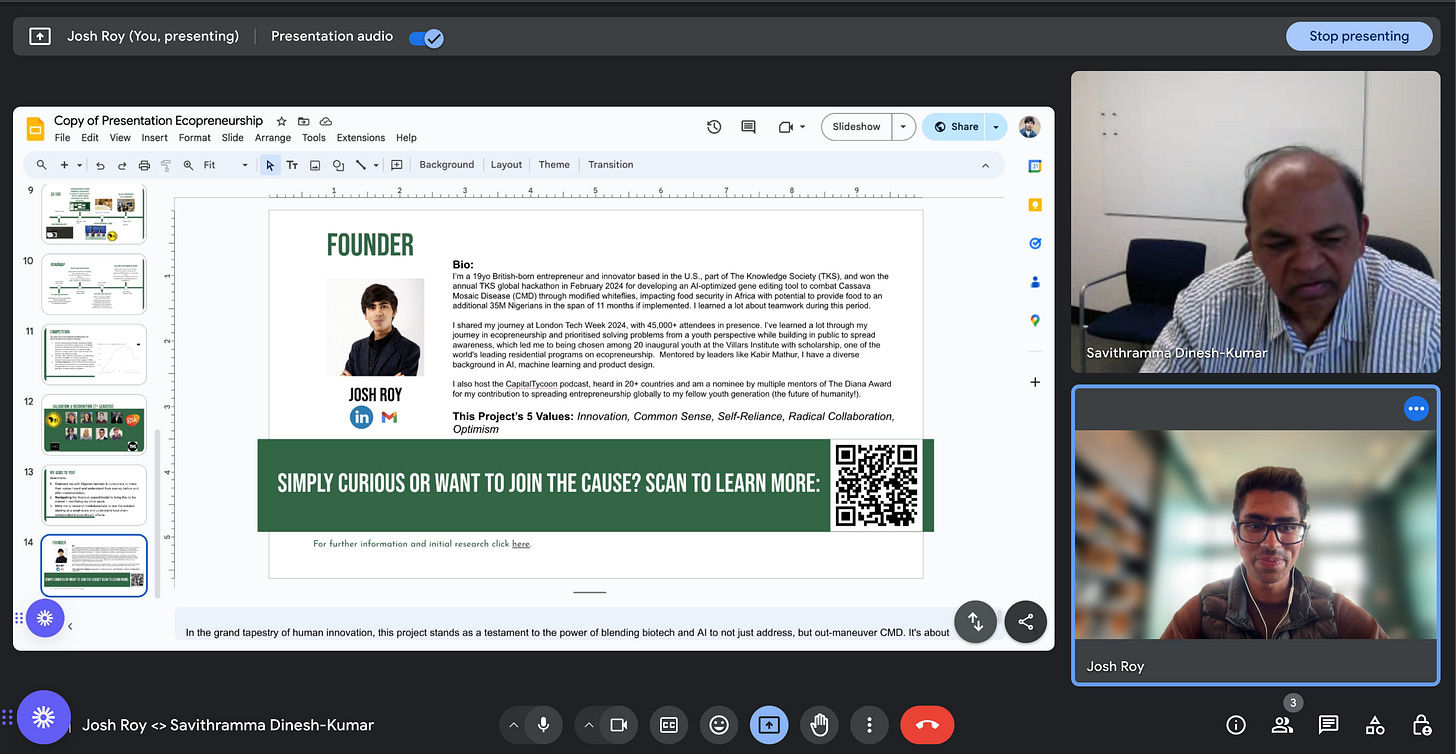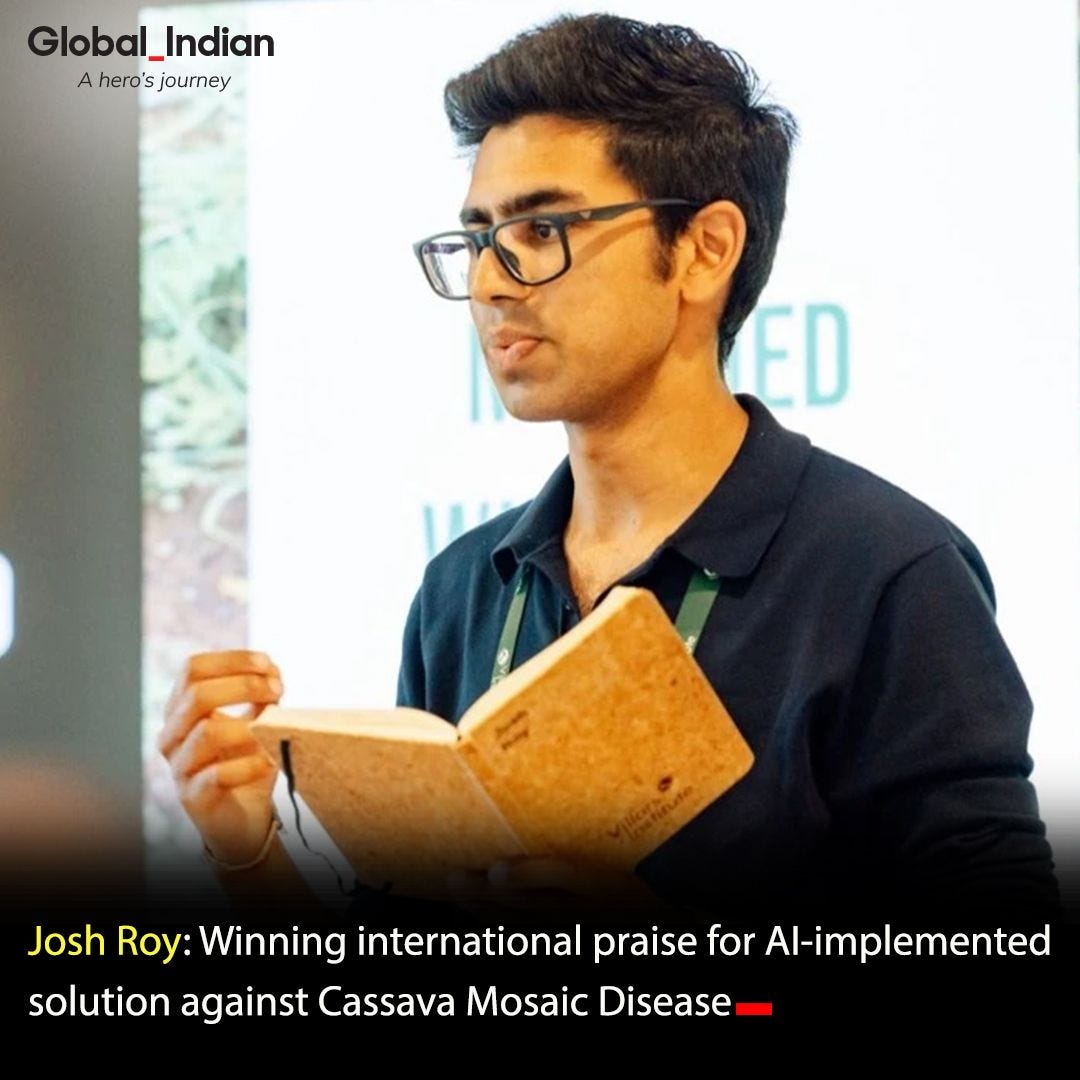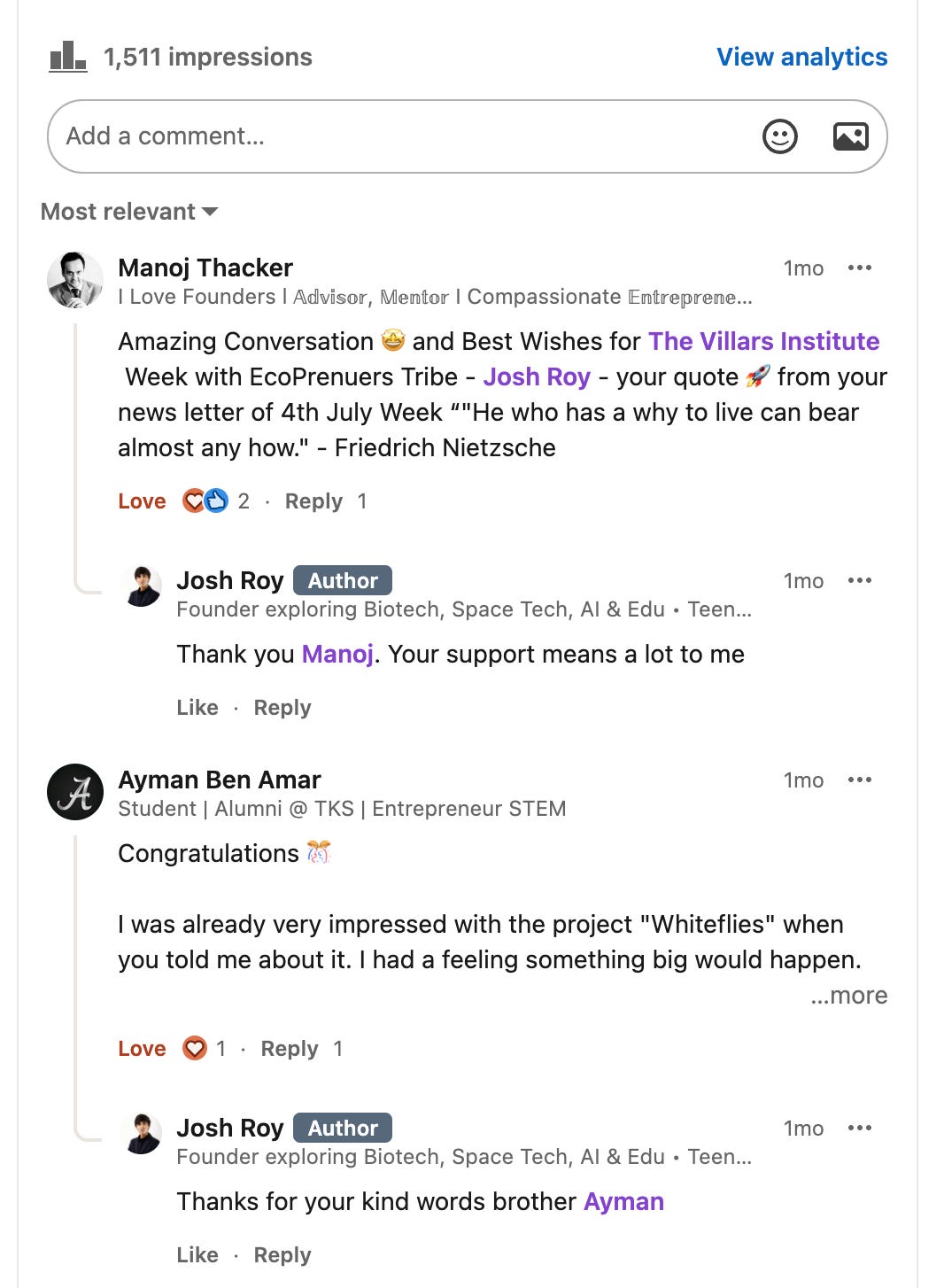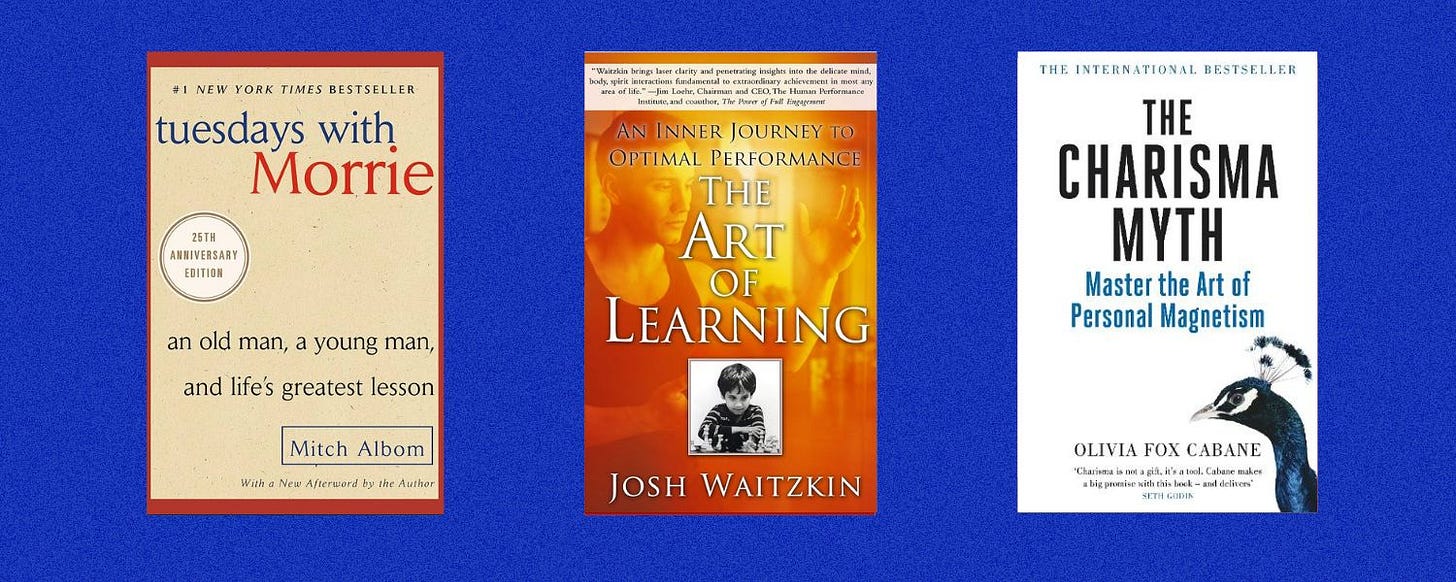Securing a Research Opportunity for Food Insecurity Project, Grant and Next Steps
September Newsletter
Hi! If you’re new here, I’m a youth design engineer, tech builder and founder. Currently, I’m building tech projects in the intersection of AI and other kinds of emerging tech such as gene editing :) Previously, I’ve worked alongside WEF for an education project, was recognised for being the first individual to study and implement the world’s first Universal Indian Drum Notation system and won the annual TKS Focus Hackathon for best solution.
Progress with Food Insecurity Research🌱
As is with previous newsletters of mine, I’m writing this in reverse-order to help you picture in your mind my personal growth - reverse engineering from my outcome at the end of the month to where I was at the beginning of the month.
Throughout the month, I used most of my professional time to do a couple of things: making tangible progress with my project by building in public through sharing weekly vlog updates and achieving a threefold goal: 1) getting my project known through communication, 2) gaining legitimacy for the science/policy aspects, and 3) highlighting the voices of both Nigerian and international stakeholders involved.
You can view my project updates I delivered from this month below:
Exchanges with Professors🧐
Dr. Lee Howell (Executive Director, The Villars Institute; Professor at University of Geneva and Board Member, International Baccalaureate and EAT Foundation):
At the end of the month, it was nice speaking with Lee after we met the Villars Ecopreneurship Program in Switzerland. Once again, I thank him for your time and ongoing support. Hearing about his experiences was insightful - particularly about his inspiration to join the cause of Villars with the ‘theory of change’, his perspective on how all parallel problems lead to the food system - it being the 'nexus', and his balanced perspective on the world having grown up in Japan and Asia as well as studying in the US.
I will keep the action items he recommended in mind pertaining to my food insecurity project, O-1 US visa application and communicating to the public. Lee, I look forward to touching base and learning more from you again!
Dr. Vincent Fondong (Delaware State University):
I also had a call with Prof. Vincent Fondong of Delaware State University (leading US-based researcher on CMD) for the plant aspect of my project. In fact, Prof. Fondong agreed to be my preceptor, provided I secure a grant such as from the Bill & Melinda Gates Foundation or National Science Foundation (both with whom the professor has been awarded grants previously). Will be sharing an update on securing grants to support the lab trials and research phase of my project next month.
Prof. Yen-Wen Kuo (UC Davis):
I thank Prof. Yen-Wen, a molecular epidemiologist, once again for agreeing to support me on my cause and for the whitefly aspect of my project. It was insightful to hear about what inspired her to study viruses, and I'm confident her input will be a boost to my entrepreneurial journey for the foundational R&D stage in tackling viruses causing plant diseases.
Here are a few valuable insights/action items I gained from her:
- Transgenic whiteflies in order to silence the gene of the whitefly. Inject RNAi/molecules, that will have to be via a transgenic method. If you want long term effects to silence certain genes in whiteflies, one way is to use this method.
- In our lab, we are silencing certain targets to not be able to transmit bacteria from insects. This is another way to do this.
- Use the effects, releasing transgenic insects (like with the GM Mosquitos for the world mosquito program for disease control tests)
- Using insect viruses to affect passing of certain pathogens (novel, and difficult). RNAi for long term silencing. Bacteria in insects. Modification of bacteria.
- We need to study how whiteflies acquire viruses on infected cassava, and how long they can stay silenced and circulating the insect and going through the gut barrier/other barriers to reach the salivary glands. Decide what target you are looking for and study that e.g. gut barrier, dissecting gut barrier for bacteria. Genes activated/downregulated, circulated into in salivary glands - what kind of things are being activated/downregulated.
- AI for predictions is a good idea. There are 100s of candidates, AI may help which one will be more possible. Benchwork to verify the targets (hard part) through AI. You need to know what silencing affect the gut barrier reaction/short term reactions. To see the actual transmission rate, it has to be long term. Inoculation SS period. Remove insect and see if plants are infected. To calculate how many plants are infected, it will give you the transmission rate. We're not sure how long term silencing effect can't last.
Some thoughts following her insights and my further research:
We would need to specify if specific homologous recombination will be the right use case. Since if we are targeting for gene knock outs - identifying which target parameters will ultimately give us the answer as to what wet lab approach we should continue with.
Given this, we would be targeting specific regulatory motifs (like TATA box, CAAT box, Enhancer motifs, Silencer motifs, Splice site motifs) that are key in the whitefly’s salivary gland protein responsible for viral transmission. I understand that RNAi is temporary and less complete than permanent knockouts as you've mentioned. However, I chose RNAi initially because it’s more scalable and allows us to see the short term effects more easily. That said, I’m definitely considering homologous recombination as a permanent solution down the line, when and if the edits prove successful and viable for field implementation.
..
I also had an exchange with Dr. Michael Snyder, head of Snyderlab Stanford, who provided recommendations for my project and connections. Following this, he led me to conversations/exchanges with Stanford University's bioengineering faculty and researchers, including Diba Dindoust and Dagny Reese. A highlight feedback was from Dagny who advised on how to approach working with model organisms for whiteflies and suggested proof-of-principle experiments with similar organisms, like Drosophila, due to the unique challenges whiteflies present. This will help ensure my lab work is well-grounded.
The call that started it all:
It was a call with Prof. Savithramma Dinesh-Kumar from University of California, Davis (referred to me by Dr. Snyder), who informed me in our productive conversation that whitefly and cassava mosaic disease experts are primarily based in Africa, but to further my O-1 visa application, it’s crucial to have a US-based expert. This led to my connections with Dr. Vincent Fondong and Prof. Yen-Wen Kuo as my supporters for the lab trial phase. I thank him once again for his immense help, insights and connections - I remember hearing about what got him inspired into plant genetics having grown up in a farm in India!
..
Thanks once again to all professors for their time, insights and continued support.
Next month, I’m speaking with and interviewing the following stakeholders I’ve identified, all of whom I’m confident would accelerate my project: Julien de Meyer (Food Agriculture Organisation), Bernard Lehmann (Food Agriculture Organisation), Dr. Everlyne Wosula of IITA (on cassava viruses and virus vectors at IITA), Rudolph Shirima (post-doc molecular virologist at IITA), James Legg (focusing heavily on strengthening seed systems for vegetatively propagated crops (VPCs) at IITA, so that he can increase the availability of high quality near virus-free planting material of VPCs for the hundreds of millions of smallholder producers who rely on these crops in sub-Saharan Africa) and Dr. Leena Tripathi (who is IITA’s East Africa Director, as well as leading the gene editing work).
My Project in the News📰
My AI and gene editing project was featured in the news, with Global Indian interviewing me on my story. Read the official press release here.
I was also featured in Global Entrepreneur’s Festival, run by Africa’s Young Entrepreneurs Organisation, where I won the Innovative Entrepreneur of the Year category, Nigeria, back in July (a global award recognised by the President of the Federal Republic of Nigeria, and billionaire businesswoman Mrs. Folorunso Alakija), and I have been selected to be in YOUTHTOPIA Circle of Youth to communicate my project in public at stages like Festival de Cannes, United Nations and World Economic Forum in the coming months.
This has undoubtedly all supported getting my project known, and I’m grateful for the support my project has received from people with messages like these (not to mention the warm welcome I’ve received in advance from the people of Nigeria). All the people supporting my journey means a lot to me. I look forward to meeting with my audience in Akure, Ondo State!:
Update on AI x Cybersecurity Project🤖
Did you know?:
Cybercrime is expected to cost $10.5 trillion annually by 2025? (Source: Cybercrime Magazine). I published an article about the intersection of AI and cybersecurity. Why was I inspired to dig into this topic I knew nothing about just a few weeks ago?
The why:
Not long ago, when I turned on the TV I remember seeing a news story that was covering the NHS being hacked. The first thing that came to my mind was a sense of growing urgency to safeguard not just businesses, but our most critical infrastructures that are required for our livelihoods from cyber-threats. I dove deeper by reading articles, and a particular incident involving a 14-year old cancer patient named Dylan struck me. Dylan’s surgery was delayed due to that ransomware attack on the NHS, that resulted in the disruption of medical services across several hospitals in London. This heartbreaking reality demonstrated to me how cyberattacks can go beyond and directly threaten lives, not just data. Seeing this kind of real-world impact led me to explore how AI could be leveraged to prevent these devastating breaches and ensure that critical services remain intact and resilient, even under attack.
What exists:
For interesting companies making waves in cybersecurity, Leen (a high-growth startup this article was largely inspired by) offers a Unified API that simplifies security data management, allowing faster threat detection. Darktrace pioneers AI-driven cybersecurity with autonomous threat response, while CrowdStrike's Falcon platform uses AI to detect, prevent, and respond to threats in real-time, leading endpoint security.
What's next?:
I'm going to be building a series projects over the coming weeks that I will share in public for feedback, aiming to become a novice to an expert in these fields. Note this first one is an introductory "learn" article about the topic, aiming to share what I've learned about these fields.
Read my article here.
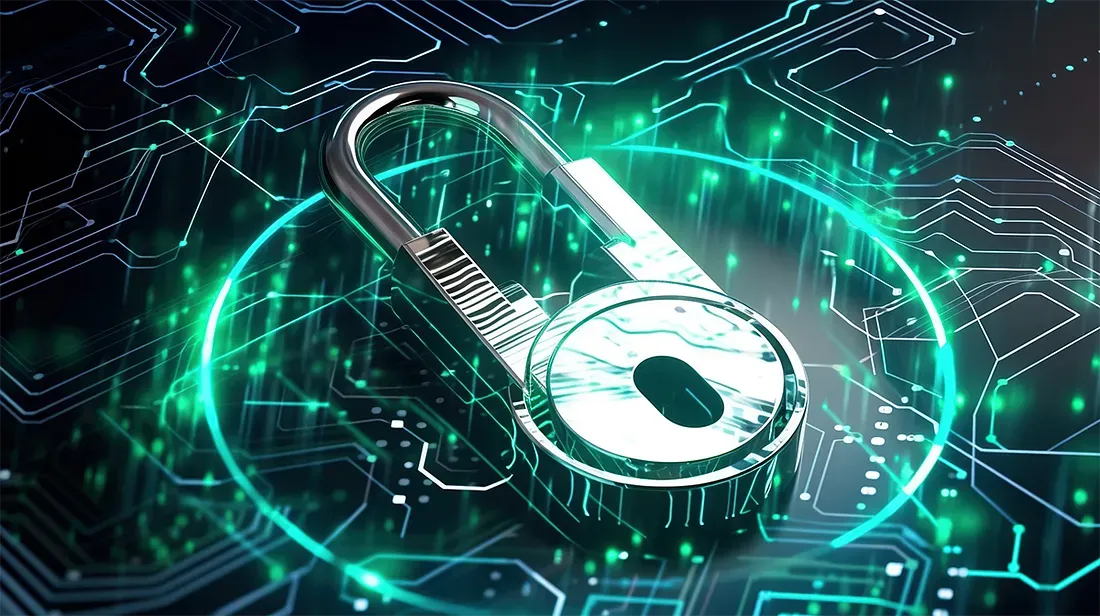
Speaking of getting into another field that interested me:
As my mentor and role model in entrepreneurship John Spence (Chairman and Founder, Karma Group Global) wisely said recently in his monthly video update, “Someone said to me the other day why do you do so many things or how can you? Well, basically because that's what I like doing!"
His philosophy resonated with me, as I’m at the stage of exploring different fields as a youth, then going deep and building in more than one area (which I enjoy doing) and though I realise have quite a bit to learn from people and resources at my disposal, and generally it is said its better to prioritise one thing later later down the line, I enjoy satisfying my curiosity in many different fields of technology, but all of them I consider to be encapsulated with the umbrella of entrepreneurship (which is my one professional focus, alongside mastering the Indian tabla).
Interview of the Month🎙️
Theo (
) A.K.A The Battery Man!, based in Montréal, Canada, a high school student obsessed with the future of sustainable energy. At the age of 15, he started working in a top electrochemistry lab focusing on lithium-ion battery research. He then interned at CertCenterCanada, an aviation company, working on Hybrid Electric Planes and Wind Turbine sensors. This then led him to work with Longbow Capital where he reviewed 5 to 20 million dollar deals with some of the most innovative climate tech companies in the world. Just recently he came back from Uganda, working on installing mini-grids in the rural Northern Regions.I first met Theo through a couple of common programs we’re both a part of: The Knowledge Society (TKS) and The Villars Institute, and we’re in touch given our missions of making a positive impact through sustainability. It was an insightful discussion with a dope guy. Learning from driven and adventurous people like Theo convinces me that making a meaningful difference in the world from a youth angle is possible, and I’m lucky to call him a friend. We discussed his recent internship in Uganda, being part of TKS/Villars and standing out from the crowd as a youth.
Highlight insight from our conversation: Under-promise and over-deliver. “As ambitious people, we wanna deliver the most amazing work ever, right? I give myself no room for mistakes and I don’t do that because of course I make a mistake, I’m human or one day is bad. And as a result, I hurt my trust with a lot of different people who would’ve given me more opportunities if I hadn’t hurt their trust. Don’t set too high expectations. At one point, if you can’t deliver on it and if you’re just wishfully thinking that you can, it’s going to ruin your reputation with a lot of people. So, set lower expectation goals and absolutely do well on those goals and crush them beyond people’s expectations. Don’t set huge goals and then not end up delivering them.”
Listen in to the episode here!
Learning a Life-Skill: Dance!
After my experience at Villars last month, I decided that I wanted to get good at dancing. So I joined a dance school this month!
I picked up salsa, bachata, merengue, foxtrot, hustle, waltz, wedding and Argentine tango.
Shout out to Arthur Murray Dance School! It’s only been a month and they already feel like my family.
Watch the above video sequence to see my dance with my partner Evelyn, other learners and a party they kindly threw for me.
Reader Shout-outs
From this month’s issue, I will be selecting three people at random who have opened and spent time reading my previous newsletters as subscribers. This month, they are:
Dr. Fausto Artico (Former Global Head of Data Science, GSK)
Dr. Lee Howell (Executive Director, The Villars Institute)
Sahil Bloom (Managing Partner, SRB Ventures)
Many thanks for supporting the early stages of my journey (and for being my business inspirations!). Next month, I will select another three of you as appreciation for reading through my newsletters thoroughly.
Monthly favourites & media that I’m consuming
📖 Currently reading:
Tuesdays with Morrie by Mitch Albom: After hearing about this book from a friend, I started reading quite a heartwarming true story of an elderly professor who is positive yet suffering from the same disease as Steven Hawking with a few years left to live, sharing life lessons with an unhappy but healthy 20 year old student. I could not help but when reading this realise the importance of a balance between everyday life and a much needed perspective, zooming out, like when you’re dying.
My main takeaway from it which I’d like to share with you and how I came to realise it can be applied to our own lives is the fact that we need balance in this day and age. Balance between our hectic lives where we often forgo people/things we take for granted and being grateful (being acutely aware that we are only given one life). In this case, this balance was symbolised by Mitch and Morrie respectively.
In one of the final Tuesdays, Mitch speaks of Morrie as being “fully present”, as if when talking to people there is no one else in the world. This presence and strength of mind is what kept him going, and in fact positively (despite knowing he was dying). My personal spin on this is that our generation especially, in the age of smartphones, are much needed of this.
It’s a book that truly struck a chord with me, and one that I’ll read again from time to time.
Side note: I could not help but think of the importance of spending as much time with my Grandfather, who is thankfully healthy and is approaching 100. He has visited America from India for a while and I think many people might be negligent of not spending enough time with the ones we care about, owing to our “busy” lives. In a way, Morrie’s character traits and positive mindset reminded me of my Grandfather.
4 chapters in, here’s my favourite lesson from Morrie: "Why are we embarrassed by silence? What comfort do we find in all the noise?"The Art of Learning by Josh Waitzkin: Re-reading this book which I read last month with the intention to internalise the concept of and applying mastery. Authored by a former top child chess player and martial arts world champion, I decided to pick up this book again to learn how to apply mastery to my two foci in life: entrepreneurship and tabla (my professional and personal endeavour respectively). As my Father says, focus on a maximum of two things (preferably one) and become exceptional at them rather than being a jack of all trades. I found it to be a good peer into the mind of someone who has found a method into becoming exceptional at fields, in different decade-long phases of his life. An interesting analogy included seeing tai chi and chess as mirrors and how small subtle actions build momentum toward a win - whether it’s a powerful chess move or a fluid martial arts strike. Favourite quote: "One of the most critical factors in the transition to becoming a conscious high performer is the degree to which your pursuit stays in harmony with your unique disposition."
The Charisma Myth by Olivia Fox-Cabane: Started reading with intention of improving my public speaking skills. Short but important insight: “Presence, power and warmth are the 3 ingredients of charisma.”
Intentions for Next Month
Thank you for reading this newsletter. Going into October, I’m going to be travelling to Dubai during a major part of the month for a formal internship and speaking at a global conference, lay the foundations for my lab work and positioning my project for a grant, & take my AI and cybersecurity project series to completion while receiving feedback from industry experts. See you then👋
P.S. I dedicate this month’s newsletter to my paternal Grandfather from Kolkata, who has been a big support along with my Father for my unconventional path and my work to solve humanity’s biggest problems through entrepreneurship (or should I say, ecopreneurship!). He left for Kolkata earlier this month and I will forever cherish the fond memories with him of the last 3 months with him visiting us in Chicago.
To complete this newsletter, below is a video for you showing my nearly 100-year old Grandfather trying the latest Apple Vision Pro. It was a fascinating to see him trying out a new emerging technology in xR. Especially coming from a different generation, seeing him was like when baby is exposed to a new toy❤️




